
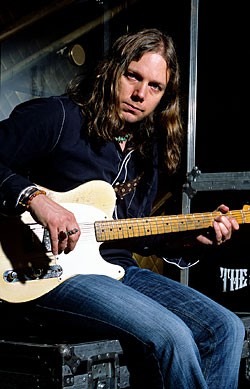
Rich Robinson. All photos by Neil Zlozower.
Emerging as grunge began casting a metaphorical pall over the pop music landscape of the early 1990s, the Georgia-based Black Crowes offered something decidedly different in its reverential mix of rock and roll that delivered an update on the promises made by the likes of the Rolling Stones, CSN, Jeff Beck, AC/DC, the Faces, and even R.E.M.
And it hit big right out of the chute, as its 1990 debut album, Shake Your Moneymaker, went platinum while simultaneously putting the band squarely atop not only the charts and MTV playlists, but firmly in the consciousness of music fans of the day.
The band, formed by brothers Chris and Rich Robinson, employed an always edgy live show with an ever-changing setlist that delivered a mix of raucous rock songs, extended jams, and some of the era’s best ballads. Fans who feasted on the band’s musical amalgamation – and connection with its audience – dubbed the Crowes’ musical style “freak and roll.”
The band saw continued critical and commercial success with its 1992 followup, Southern Harmony and Musical Companion, which, while it marked a progression in the band’s style and ability, staunchly maintained an independence and creative freedom that became the band’s trademark. Subsequent albums saw the band continue to evolve while remaining amazingly consistent in regard to the quality of its output; the band sold more than 19 million albums worldwide and along the way shared the stage with Jimmy Page, Bob Dylan, The Rolling Stones, Aerosmith, AC/DC, The Who, Neil Young, The Grateful Dead, and other legends.
But the path hasn’t been without pitfalls. Like any band that displays a degree of staying power, personnel have changed. For instance, guitarist Jeff Cease was dismissed after the band’s first album, replaced by Marc Ford, whose tenure was on-again/off-again, and shifted to off-again just two days before the band toured in the fall of 2006. Still, the outing proved successful, and the months following saw the Robinsons writing songs for a new CD and DVD, titled Brothers of a Feather, set for release later this year.
Rich Robinson has always been a fan of true vintage guitars and amps. Some of his first chords were strummed on his father’s 1953 Martin, and after wading through a few beginner instruments, 400 of his first hard-earned dollars were spent on a used Fender Telecaster Deluxe. And while he makes no claims about being a “great” guitarist, he knows full well how classic equipment and good tone can inspire a musician.
Do you remember when and why you first started paying attention to music?
Chris and I grew up listening to everything – Joe Cocker, Sly and the Family Stone, Bob Dylan, the Chieftans, to Aretha Franklin and everything in-between.
This was stuff on your parents’ record player?
Yeah. My dad was a musician, so he would play a lot of traditional folk and country songs. And mom was from Nashville, so she grew up listening to all that stuff. Dad was in a folk band trying to get on with CBS Paramount back in the day.
When you were young, did you pay much attention to his guitars?
Not really, but as we got older, he let us play them. He had this really cool one made by the Gauer brothers, in Tennessee. It’s a dreadnought-style, but a little thinner, with a really interesting sound and an Egyptian-style mandolin headstock with tons of mother-of-pearl inlay. It’s a really cool guitar.
Do you still have it?
I still have it, yeah. I also have his ’53 Martin D-28, which is beautiful. We used it for songs like “She Talks to Angels,” on the first record.
What first got you interested in playing guitar?
AC/DC. I loved Angus and Malcolm Young, and the way they played together. As a teenager, that was the first music that I got way into. I also loved Parliament Funkadelic and Prince at the time, and obviously Crosby, Stills, and Nash was a huge influence back in the day.
As I got older, Dad would let me play his guitars. I’d try to pick out things; the first song I learned to play was “Oxford Town,” the Dylan song from The Freewheelin’ Bob Dylan. Then I started getting into learning R.E.M. songs and things like that, because R.E.M. was huge in the South when I was 14 years old. I picked up the guitar for the first time when I was 15, and taught myself.
Were you a quick study?
I was a quick study in learning chords and writing songs. I was never the guitar player who sat in his room and learned scales. I was way – and still am to this day – more interested in songs than people. I love and respect people who can play well, but I think songs are truly a gift, you know? I think people who can write great songs… there’s just nothing better in the world, to me. So I immediately started writing songs that we started playing in clubs.
At first, we were a punk band. But there was this paisley underground scene going on in pop music at the time, and we used to love what bands like the Rain Parade, Dream Syndicate, and the Street Club were doing. And we sort of outgrew our little punk phase and started delving into different kinds of music like that.
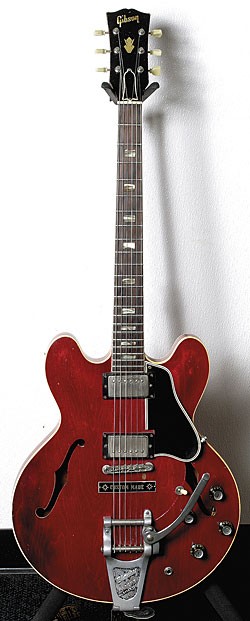
Bigsby-equipped ’60s Gibson ES-335. All photos by Neil Zlozower.
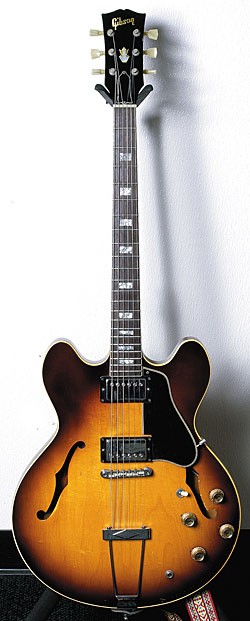
’60s Gibson ES-335 in “tobaccoburst.”
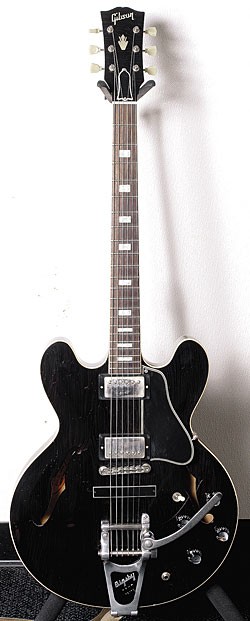
Gibson Custom Shop ES-335 in Black.
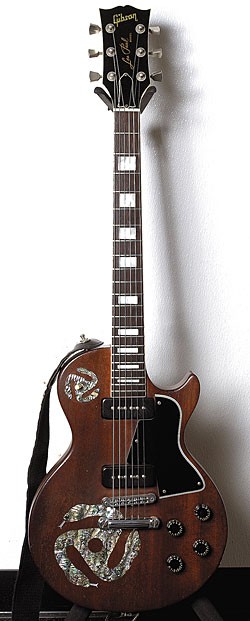
Gibson Les Paul Special with the custom “Three Snakes” inlay.
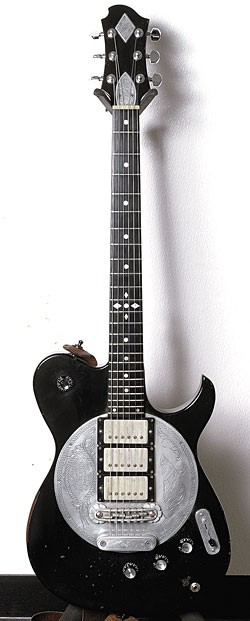
A Tony Zemaitis disk-front with custom Black Crowes engraving.
How did AC/DC fit into the list?
I was nine or 10 years old when I started listening to them, and their music made me want to play the guitar. I remember If You Want Blood… You Got It, their live record. I loved “Riff Raff” – that was an amazing song to me at the time. I never tried to play AC/DC songs, I just so appreciated them. Being a kid, it was exciting, powerful rock and roll music. Everyone calls them a heavy metal band, but they’re just a f***in’ rock and roll band, all day.
And as I got older, got into more things, and started delving more into music, I started getting back into Crosby, Stills, and Nash, Sly Stone, The Byrds, The Beatles… all those bands.
Do you count Peter Buck, the guitarist in R.E.M., as an influence?
He’s not really a guitar influence, but R.E.M. songs of the day – Murmur had some great songs, Reckoning and Fables of the Reconstruction – those three records were the ones for me, as far as songwriting goes. I know these are really weird, sort of all-over-the-place influences.
Do you think any them have affected the way your guitars, amps, or playing style sound?
I don’t think so. I think tone is 90 percent about the way a person plays, not which instruments they play.
It’s in the hands…
Yeah. I play different amps and guitars, and it always sounds like me, though sometimes in a weird way.
Even back when you were playing your dad’s guitars, you had your hands on good stuff.
When we were kids, I had a new Tele; it might have been a Squire. The very first guitar I called my own was one my parents bought me… a crappy Lotus copy.
But what was the first guitar you bought for yourself?
I had a bunch of weird guitars when we first went out, because we couldn’t afford good guitars back then. The first decent guitar I bought was a new Rickenbacker in sunburst finish. Then I bought a Robin.
Made by Dave Wintz, in Houston.
Yeah, that was pretty cool. Then I had this weird Tele… I would always just buy these guitars, play them for six months, and then trade ’em for something else. I never had a multitude of guitars. I once had this huge hollowbody Gibson. I can’t remember what it was but, it fed back a lot, so I had to get rid of it.
The first really good Fender I bought was a black Custom Tele from the ’70s. And then I bought a ’68 blond Tele and that’s been my main guitar ever since. I paid 400 bucks for it.
It’s still out on the road with you?
Yeah, I still use it, and this weird goldtop Les Paul that I’ve had forever, that some dude tried to shave down – there’s an area where there’s no gold anymore. It used to have a Bigsby on it, but I took it off while we were recording Shake Your Money Maker. I’ve had those three guitars since I was a kid.
Is that the goldtop you take on the road?
Yeah. I don’t know what the hell it is – a ’50s reissue, maybe? Whoever had it before me had an ’80s Dimarzio heavy-metal pickup in the bridge, and in the neck position it had a P-90. Instead of just trying to fill in the P-90, I routed it out, because the whole thing was so f***ed up anyway. The headstock was cracked at some point, but we had it fixed.
When was the first time you bought a guitar that was collectible the instant you bought it?
In the middle of the tour for Shake Your Money Maker, I bought a ’58 sunburst Les Paul Junior in immaculate condition. I’ve since sold it, but I’ve had well over 100 guitars since then. Some I sell, some I keep.
So how many do you have right now?
I don’t know, really. I take, like, 36 guitars on tour, and I have another 20 or 30 in storage.
What sort of stuff is in storage?
I have a Charlie Christian from the ’40s, original, with a lap steel and a matching amp. And I have the Gauer in storage, another few Teles, this weird old Gretsch that has two f holes and one really cool old pickup. A bunch of basses – a cool Tele bass, a Jazz Bass, and a P-Bass. My dad’s Martin is there, and another D-18, it’s either a ’58 or ’61, along with a couple of Taylors and a couple more Trussarts. And there’s more.
Do you buy certain guitars because you want to try certain sounds, or are you buying them to have a collection?
I definitely buy things to get certain sounds. I don’t really care about collecting. It’s nice to have great guitars, you know? But to me it’s more about what sounds good. That’s always what it’s been. I have new guitars; I bought this Duesenberg, which is great, and I have the Trussarts. The new Zemaitises are really good. There’s this guy in Tokyo who makes these Freedom guitars that are great, really well-made. I have a couple of Fender Custom Shop Teles that sound f***in’ great.
There’s a lot of new stuff out there that’s really good. So it’s not about collectibles, it’s about what sounds good to me.
Have you ever had any ’50s Teles?
I have a ’54 Esquire – its either a ’54 or ’55, I can’t remember. I originally had a ’61 and it was stolen in either Chicago or Grand Rapids. So there was a guitar shop in Hoboken – and it might have been Hoboken Guitars – but they had this ’55. After I got mine stolen, I found this one and it was just f***in’ great, has a baseball bat for a neck, and sounds amazing.
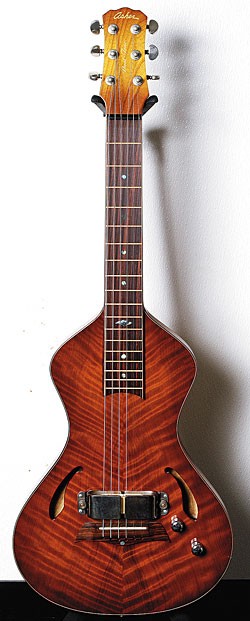
Bill Asher lap steel. All photos by Neil Zlozower.
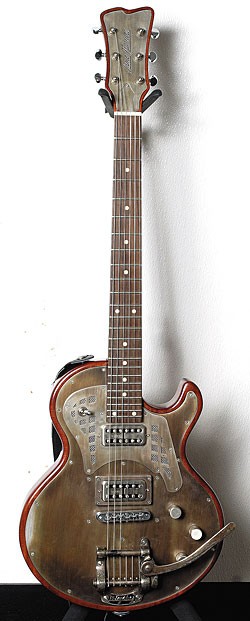
James Trussart Steelphonic with TV Jones Filter’Tron pickups and Bigsby tailpiece.
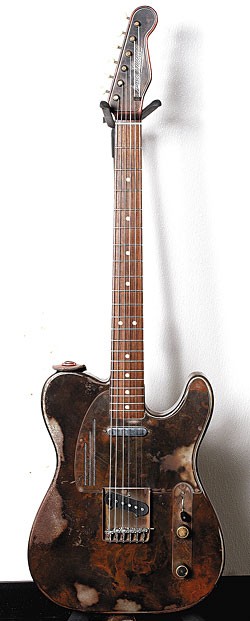
James Trussart Rust-o-Phonic.
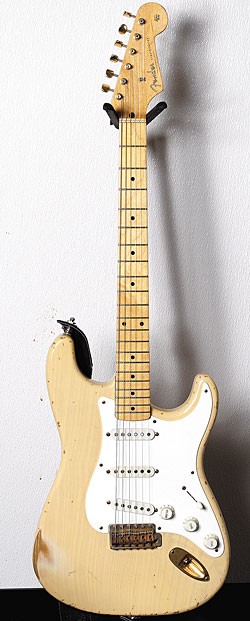
9) Fender Mary Kay Stratocaster with Custom Shop parts.
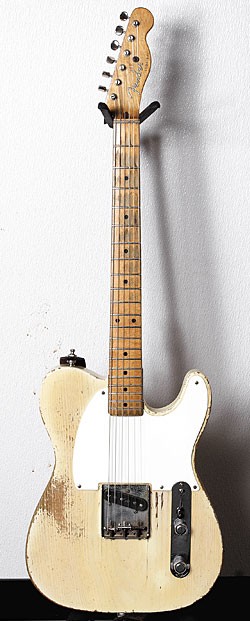
Mid-’50s Fender Esquire.
And you’ve used many different amps through the years, right?
Yes. I’m into just trying different things, you know? When I started, I used Marshall Silver Jubilees. That was before there were any independent companies, really. You didn’t have the boutique amps; you had Fender, you had Marshall, you had Vox, you had Laney; it was pretty limited.
On our first tour, I used an old blackface Showman and the Marshall Jubilees, and my rig sounded really good. As we went to make Amorica, I started getting into vintage amps because I could finally afford them. I bought a bunch of tweed Fender Vibroluxes, I bought a really cool brownface blond Tremolux that sounded great, a ’71 50-watt Marshall that sounded really good – just random amps – a Gretsch, a couple of Supros, things like that.
By the time we recorded Amorica, our engineer had gotten to know Mark Sampson, when he was still building amps one by one, and I bought five or six from him… maybe more. We each bought two Clubman amps, and he made us each a Chieftan. They were really, really well-made, great-sounding amps, and we got into the different tones. I used them to record all of Three Snakes and One Charm, and Amorica. Then I got into the Harry Joyce stuff after someone told me Harry was making amps again. He made all of Pete Townshend and David Gilmour’s amps, and I always loved their tones. So I called HiWatt to check it out, and they sent me an amp, and it just sounded great. So I stuck with that for awhile.
But now, there’s all these really cool boutique-amp companies making great amps. Wayne Jones at Headstrong amps is really good. I use one of his 30-watt amps. And 65 Amps made me this cool 55-watt amp with one channel. It sounds really good. I use all of them to get my sound. It’s not always simple, but it needs to sound basic.
How many amps do you have at home, and how many do you take on tour?
Well, on tour I have the Headstrong, the 65, and my Marshall Silver Jubilee. At home, I have three different-sized Supros, some Wizard amps; one is a hybrid with two transformers and sounds like two amps in one. One of them sounds more like a Showman, and one sounds more like the Silver Jubilee. They’re great-sounding amps. Then I have some Orange amps, a new Fender tweed Twin that sounds really good, three tweed Tremoluxes, a couple of original tweed Bassmans, the Matchless stuff, that ’71 Marshall… there’s tons of stuff.
Two of my Matchless combos just got stolen, which really pisses me off.
Where were they when they disappeared?
In my storage space. Someone walked in and took them out of the cases and put the cases back. They’re custom-made, covered in tweed, and they sounded great.
There was other stuff there they could have stolen, but didn’t?
Yeah, it doesn’t make any sense. It was like someone knew what they were. Maybe they thought we wouldn’t miss them for awhile… I don’t know.
From day one, the Crowes have been compared to the Rolling Stones. But what are some other influences on the band’s sound?
Mick Jagger is a huge one; I love the way he plays guitar and writes songs. Sly and the Family Stone is another huge influence, and always has been. Then there’s The Faces, Crosby, Stills, and Nash… all the bands we grew up listening to – Parliament, Joe Cocker, The Jeff Beck Group, the Byrds, the Beatles… Gram Parsons, all of that is in there.
And then you’ve got the whole Led Zeppelin thing…
The minute we played with Jimmy [Page, to record 2000’s Live at the Greek, a mix of Led Zeppelin covers and other blues songs], people started comparing us to them. All of a sudden it was “They’ve always ripped off Zeppelin!”
Are there any comparisons you’ve heard through the years that didn’t make sense, in your opinion?
Well, I was 19 or 20 when we recorded Shake Your Money Maker, and I’d been playing guitar for only four or five years. When you’re young and don’t have a lot of experience, you wear your influences on your sleeve. So there we were, making our first album, and we wanted it to be our Beggar’s Banquet or Exile On Main Street! But with Southern Harmony, our sound became our own. After that, when people started comparing Amorica to the Stones, or even Three Snakes, the comparisons just started getting really silly. It’s like the dips***s had never really listened to these records; Amorica and Three Snakes had nothing to do with the Rolling Stones. If you listen to those albums, they’re completely different. Lions has nothing to do with the Stones; I mean, By Your Side was more of a straight-ahead rock and roll album.
If you look at our career, because our first two records were so successful, that’s what everyone reverts to. But we really took a left turn with our songs, and really pushed ourselves and tried to do different things. But because of the laziness or ignorance of some journalists, so many of our other the influences were never discussed. As we got away from the Stones thing, we really got away from it.
The big news these days is that you’re getting set to make a new album. Are you planning on playing all the guitars yourself?
Well, Paul (Stacy, the band’s producer and touring co-guitarist) is going to be there, so we’ll see what happens. It just depends on everyone’s schedule and what they want to do. Everything is up in the air right now.

Rich’s (main) Axes
Three guitars (LEFT) have been Rich Robinson’s go-to axes since the earliest days of the Black Crowes. His ’70s Fender Custom Telecaster was the first serious guitar he bought, followed by his longtime primary guitar, a ’68 Telecaster with a humbucker that had already been installed when he acquired it. He removed its Bigsby vibrato while the Crowes were recording their first album. The Les Paul was also “altered” by the time Robinson bought it.
Stay up to date with Rich at http://richrobinson.net
 This article originally appeared in VG‘s June 2007 issue. All copyrights are by the author and Vintage Guitar magazine. Unauthorized replication or use is strictly prohibited.
This article originally appeared in VG‘s June 2007 issue. All copyrights are by the author and Vintage Guitar magazine. Unauthorized replication or use is strictly prohibited.


